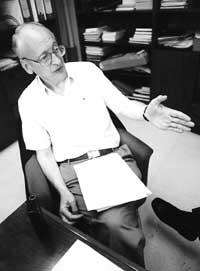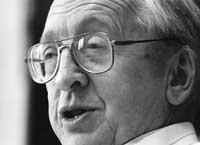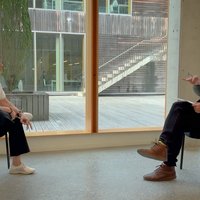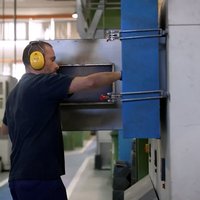Chatting with Archie Howie
Professor Howie, with the excuse of the discovery of the electron and the contribution of various precisions in this regard, explained the influence of the discovery itself on the evolution of physics in the conferences given in Donostia and Bilbao. To enjoy a committed and simple word, the auditorium of the Miramón Technological Park welcomed about 60 people, most of them professors, researchers and students from the Faculty of Chemistry. The surprise was great because we could see and hear a historical document: J.J. Thompson, E. Rutherford, A. Einstein and J. Cockcroft video talking about his works. Your position and responsibility do not bear the identity of Archie Howie. We meet a friendly and welcoming person. He is a regular visitor in the Basque Country and has great esteem for his Basque colleagues.
ZETIAZ-ELHUYAR: What influence has the discovery of the electron had on the development of physics?

A. Howie: The first consequence was the invention of electromagnetic wave detection tools, thermoionic valves. Then came the development of atomic models and quantum mechanics, basic physics. But from the social point of view of electron discovery, the last fifty years have been the most outstanding. In fact, microelectronics and all consumer products have been developed during this period. For people who are not interested in understanding the essence of science, transistor has been the most obvious consequence of electron discovery.
On the other hand, the electron is somehow the nexus of scientists working in different fields, as they need an electron in their computers, tools, etc.
N-D: It is sometimes heard that physics has touched its ceiling, that it does not need new theories, that only techniques are needed to apply current theories. Have you really touched Physics?
A. Howie: It can be argued that many ideas of physics have come out of the field of physics and are now being applied in other fields. For example, DNA research is done by biologists and the quantum theory of the union is used by chemists for their research. However, in physics there are fields that have a lot to do: works on elementary particles, astronomy, cosmology. The latter is in full swing due to the discoveries being made. In solid-state physics, which has been virtually completed, there is much work to be done, for example, for high-temperature superconductors. The phenomena that occur inside high-temperature superconductors are still not well understood.
N-D: Pulled by the thread of elementary particles, it has recently been questioned whether the electron is a basic particle.
A. Howie: The truth is that I am not an expert in the latest developments in this field, but in times proton and neutron were considered elementary particles and for twenty years they are not known or composed of quarks. A month ago or the essence of the electron is questioned. However, a complete statement has not been made but rather a question mark.
N-D: What are the areas of physics that have important problems to solve?
A. Howie: I mentioned some before, like the high temperature superconductor, but there are others. One of them is the chaos theory. Some simple parts of physics are not very well explained, for example, a problem related to the electron. It is unclear why static electricity is generated when rubbing the skin and a glass bar.
N-D: Electron microscopy is your area of work, what is the current state of this technique?
A. Howie: Electron microscopy has taken a long time to develop its full capacity and only in the last five years has the separation of atoms been achieved. At this time, electron microscopy has an interface analysis resolution, such as the silica/silica oxide interface, very important in microelectronics. It can be seen how oxygen concentration is changing at atomic scale. However, the maximum limitation of this technique is that the resolution is very high with very simple structures, with very thin layers. In addition, we cannot obtain precise information about the electron and its obtaining is very important in the case of high temperature superconductors, for example, to see which parts of the threads are superoale and which are not, and their relationship with the composition of the thread and with the structural defects. Currently, electron microscopy does not have enough sensitivity to do so.
N-D: Improving spatial resolution has been a problem in electron microscopy, right?
A. Howie: Yes, that's how it has been and in this field we are always working on improving spatial resolution. In addition, the resolution of this problem has obtained fascinating results in other areas. One example is Gabor's work on 1947. In the efforts to improve the spatial resolution and the electronic lenses of that time were not very good, he came up with the concept of holography and applied it with the electrons. He was not very successful in the field of microscopy, but when ten years later the laser came, holography had a great importance in optics. However, Gabor's work has not been baladi in our field, in recent years holography is being applied in different fields of microscopy.
N-D: What is holography applied to?
A. Howie: In my opinion, holography has a future in two major areas: Recovering the idea of the gaborras, in the improvement of spatial resolution, even if this is debatable, and on the other hand, is being widely used in the study of surface effects, especially in small magnetic particles.
N-D: When you talk about the Canvendish laboratory, you see the public. Somehow, the department you run is a path for Nobel laureates. What the Cavendish laboratory really is.
A. Howie: It's the physics department at Cambrigde University and, at least in large part, we also have to maintain that historic burden. Yes, it should not swallow us.
N-D: What are currently Cavendish's main lines of research?
A. Howie: The main one is astronomy. There is a large team dedicated to radio astronomy, although optical astronomy is not ruled out. Cambridge has an optical astronomy resolution mark four times that of the Hubble telescope. We are interested in solid state physics in the field of high temperature superconductors.
N-D: What weight does biology now have in Cavendish, considering that the double helix of DNA was also found?
A. Howie: Unfortunately, very small. The truth is that the molecular biology team became very large and successful, and that dynamic prompted Cavendish to leave around 1970 and take his way. To a certain extent, for Cavendish it has been detrimental to the rupture of the close ties we had in this field of research. We have relationships in electron microscopy, we have people working on protein folding.
N-D: How many people work in Cavendish?
A. Howie: At the moment we have about 70 permanent professors, 150 postdoctoral posts, about 240 doctoral students and about 400 students. If you add to this technical and so on, we are working on it a thousand people.
N-D: What is your job now? Do you research?
A. Howie: My job is now mainly bureaucratic. I have been in the laboratory for eight years and this is the last. From there I will have the opportunity to resume research. In fact, the scientific policy carried out by the conservative party in recent years has considerably increased the bureaucratic work of the department heads. On the other hand, in my opinion, the most important job of the head of Cavendish is to choose the most suitable people when the research positions are free, because our future is there.
N-D: In the last three centuries the Cavendish laboratory has been a center of excellence. What is the reason?

A. Howie: I don't think it has always been so during these three centuries. You can talk about stars like Newton, but if not, there was decay in many times. Cavendish began to improve with the addition of external doctoral students to Cavendish. Our success is based on bringing young people.
On the other hand, the freedom of department heads is one of the reasons for the success of our laboratory. When Bragg took the head of Cavendish in 1938, he completely changed the course of the investigation. At that time our laboratory was recognized for the work of Rutherford and others in nuclear physics. Bragg almost dismantled this group and promoted other lines of research such as radioastronomy or molecular biology.
N-D: In relation to this last question, you have been on numerous occasions at the University of the Basque Country/Euskal Herriko Unibertsitatea and also collaborates with some local groups. What impression do you have of the quality of our University?
A. Howie: Well, I don't have the whole vision of the University, because my relationship is mainly with the group of Pedro Etxenike. They are doing a great job and are on the front line in the world.
N-D: In British scientific journals such as New Scientist or Nature I have been able to read some concerns about correcting the method of judging the quality of research. As head of a prestigious research center, what is your opinion about it?
A. Howie: I wouldn't say that the resolution method is not correct. It's a pretty complicated and long process, and I think it's right. The problem may be if the method is the most suitable. I would say that, in case of making a critique, it rewards short-term jobs and that, perhaps, they have difficulty in moving forward long-term prospects. It is worth mentioning the example of Perutz, who for fifteen or twenty years worked in the work of Cavendish looking for the structure of hemoglobin and in most cases did not reach any place. Finally, for this work he won the Nobel Prize. Today, this would not be accepted, among other things, because there would be no money to finance this work, as it would be left behind in the resolution process.
The problem is that in a state the size of Britain would have to choose three, four or dozens of laboratories or universities and provide very solid help. Then people would say that is not correct. Limited resources.
N-D: You have a new government in Britain. The scientific policy of conservatives has been the subject of numerous criticisms over the years. What can be expected of the Labour government in the field of science?
A. Howie: If we have to be realistic we cannot expect big changes, at least in the short term. Their fundamental problem is the scarcity of money, as in most states. There are no surpluses for its application in research. Education is one of its priorities, but that at the school level. And that, in my opinion, is well done. In schools there is a great crisis, students who now come to college do not have the same level as those of yesteryear in mathematics or physics. Therefore, I do not think there are major changes in the funding of university research. It is not possible.
N-D: Why has this crap of knowledge occurred?
A. Howie: There is more than one reason and there is a risk of being dogmatic. On the one hand is the teacher's qualification. Formerly in Britain, teachers who taught physics in high schools studied physics at university and now, for example, biologists teach physics classes. They certainly do not have the same knowledge. However, the real problem is in mathematics. Physics can be learned later, but I think that from an age of life you lose the ability to learn mathematics. On the other hand, the attitude of the students themselves towards science is scarce. This social trend is worrying, on the other hand, because those who have a poor scientific basis may be in the future able to make scientific decisions.
Professor Archibald Howie leads the prestigious Cavendinsh Laboratory in Cambridge. This physicist was born 63 years ago in Scotland (Kirkcaldy, Fife) and his professional activity has been mainly related to the University of Cambridge. He studied physics at the University of Edinburgh and from a very young age demonstrated his talent for physics. In fact, he won the first Honor Award at the end of his studies. He completed his master's degree at the California Institute of Technology between 1956 and 57 years. He completed his doctorate at the Cavendish Laboratory, analyzing the defects of the crystals deformed by an electronic microscope, P.B. Under the direction of Hirsch. He began working at the Cavendinsh Laboratory in 1961, where after several research and management work, he became Head of Laboratory in 1989. He is also a consultant to various institutions and companies: Union Carbide Corp. World Bank, A.A.T. (Bell) Laboratories and BP. |
The Cavendish The Cavendish laboratory of the University of Cambridge or, which is the same, the Department of Physics was created in 1871. Since then it is a prestigious institution of studies and research, you only have to look at its directors and professors. Cavendish teachers: J. C. Maxwell (1871-79), Lord Rayleigh (1879-84), J. J. Thompson (1884-1919), Lord Rutherford (1919-37), W. L. Bragg (1937-53), N. Mott (1954-71), B. Pippard (1971-82), S. Edwards (1984-95) and R. H. Friends (1995) Main findings: electron, J.J. Thompson in 1897, neutron J. Chadwick in 1932 and double helix of DNA, F. Crick and Watson in 1953. Personnel: 70 fixed professors, 150 postdoctoral researchers, 240 doctoral students and 400 students. Research areas: Condensed matter physics (semiconductor physics, microelectronics, high-speed photography, microstructural physics, etc. ), High Energy Physics and Radioastronomy. More information: http://www.phy.cam.ac.uk/ |
Buletina
Bidali zure helbide elektronikoa eta jaso asteroko buletina zure sarrera-ontzian










